If you’re someone who thinks you can’t keep a plant alive – this plant will prove you wrong! In fact, you’ve probably seen one at a doctor’s office, home improvement store, or hotel lobby because they’re so low maintenance. Thanks to being so easy to care for and widely liked, they’re a great option for anyone who wants a low-effort plant. So today we’ll share why serial plant-killers and seasoned plant lovers all love this spear-shaped beauty.
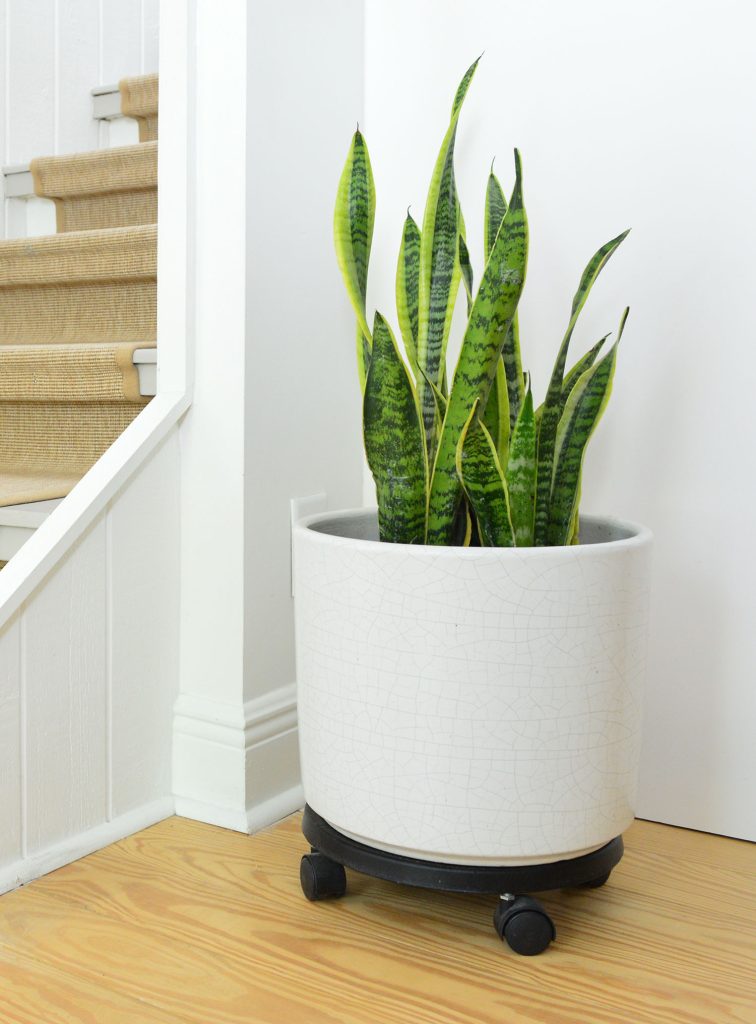
There are dozens of varieties of snake plants, but today we’ll mainly be talking about the most popular cultivar: Dracaena trifasciata ‘Laurentii.’ The Laurentii refers to the specific variant of this species seen in these photos. They’re identifiable by their stiff, sword-like leaves with bright yellow edges.
Snake Plant: Quick Facts
Here’s what you need to know about your snake plant at a glance:
- Latin name: Dracaena trifasciata (formerly Sansevieria trifasciata)
- Common names: Snake Plant, Mother-in-Law’s Tongue, Devil’s Tongue, Saint George’s Sword, Vipers Bowstring Hemp, Spear Plant
- Native to: West Africa
- Light: Prefers medium, indirect light but is low light tolerant
- Watering: About every 2 weeks or whenever the soil is dry
- Soil: Well-drained soil such as a cactus, palm, or succulent mix
- Ideal Humidity: Average household humidity
- Ideal Temperature: 70-90 degrees
- Cold Hardiness: USDA Zones 9-11
Snake Plant Benefits
Beyond being attractive and low maintenance, snake plants are also popular houseplants for their health benefits. A NASA study showed that several plants, including mother-in-law’s tongue (as they call it in the report) increase indoor air quality by filtering out pollutants. Snake plants also convert a large amount of CO2 into oxygen overnight, which is pretty unique in the plant world. That’s why many people choose to put snake plants in their bedrooms to enjoy those benefits while they sleep. We actually have one in ours!
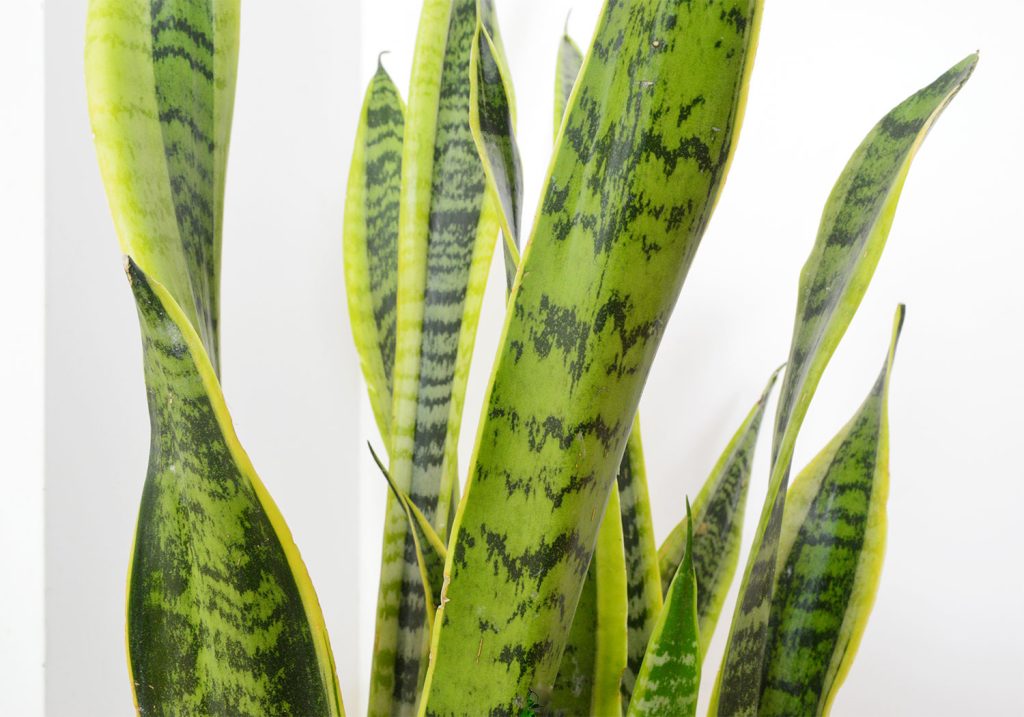
In Feng Shui, it’s also said that snake plants can attract good luck, money, and positive energy in your home. Some consider it the go-to, all-purpose plant for Feng Shui. They say snake plants are especially good near your home’s entrance to block negativity from coming inside.
What Is The Snake Plant Also Called?
Snake plants have several nicknames, some of which sound like low-key insults, including:
- Mother-in-Law’s Tongue
- Devil’s Tongue
- Saint George’s Sword
- Vipers Bowstring Hemp
- Spear Plant
In addition to these common nicknames, it may also be found under different scientific names. They have long been classified as Sansevieria trifasciata, but in 2017 genetic testing caused it to be reclassified as Dracaena trifasciata. However, many stores and plant lovers still use the Sansevieria label, so don’t be surprised to see both names still in use today.
How To Care For A Snake Plant
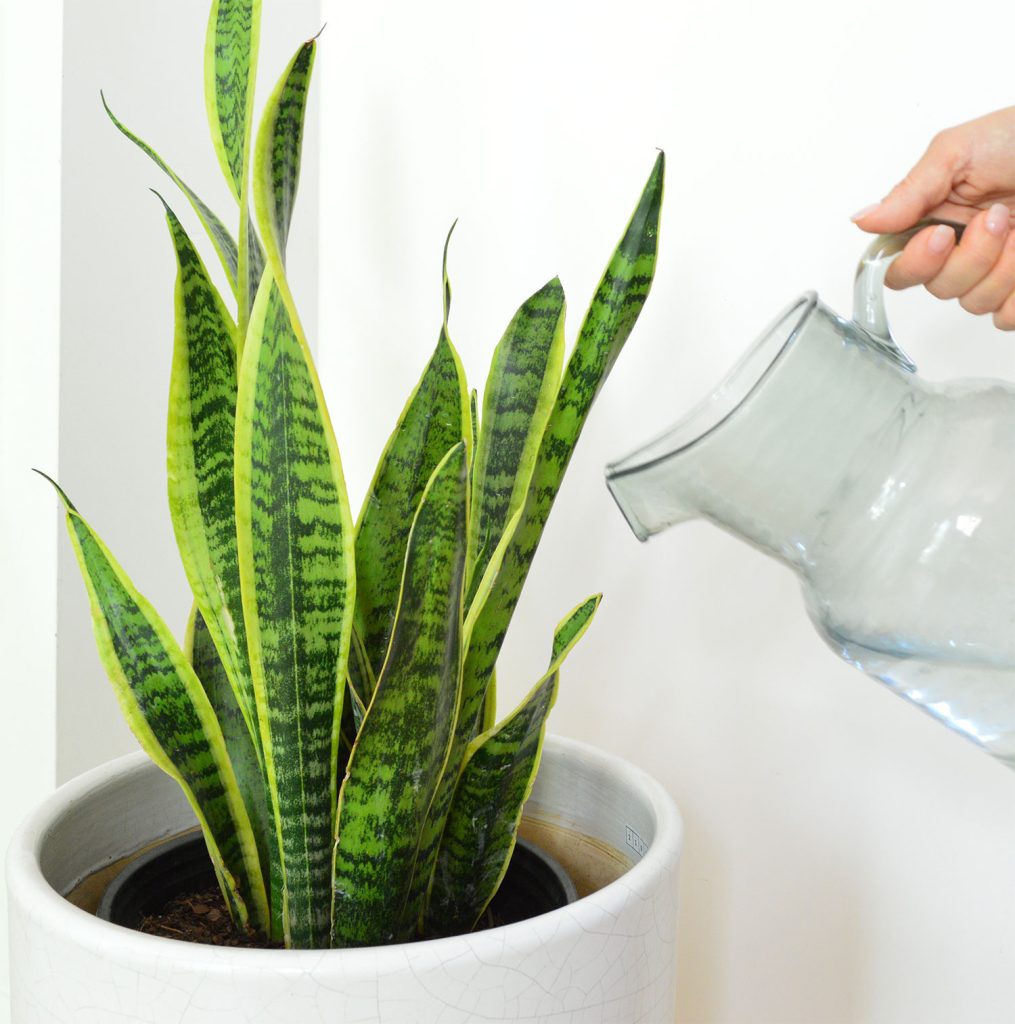
Snake plants are low-maintenance succulents that tolerate a wide range of environmental conditions. They’re a great starter plant because they’re hard to kill and don’t require a lot of attention. Here are some care tips to keep in mind.
Light
Snake plants can survive in just about any lighting condition, but they prefer medium indirect light. Too much direct sunlight can burn the leaves, while too little can stunt growth or affect its color. Still, it’s one of the best low-light plants out there! We have one in a corner of our bedroom that gets no direct sunlight, but enjoys a few hours of ambient light throughout the day.
Watering
Snake plants don’t need a lot of water, and it’s a good idea to let the soil dry out completely between waterings. We try to water ours every other week in the spring & summer when it’s growing season, and even less in the winter. Some people even wait a month between those waterings! You can always check by sticking a finger into the soil a bit. If it’s still moist, don’t water yet. If the leaves are looking brittle and crisp, it’s time to water.
Soil
Snake plants love loose, well-draining soil. The soil in storebought snake plants should be fine for the first year or two. But when you are repotting or potting a propagated leaf clipping use a soil mix designated for cacti, palms, or succulents. Make sure any pot you use has drainage holes.
Repotting
Snake plants are slow growers that don’t need frequent repotting. Consider replacing the soil after 1-2 years, but it may be up to 5 years before they require a new, larger pot. You’ll know it’s time for a large pot when you see roots growing out the bottom of its current one. Choose a new pot that’s a couple of inches wider on all sides. Snake plants especially like clay or terracotta pots that wick excess moisture out of the soil.
Other regular care
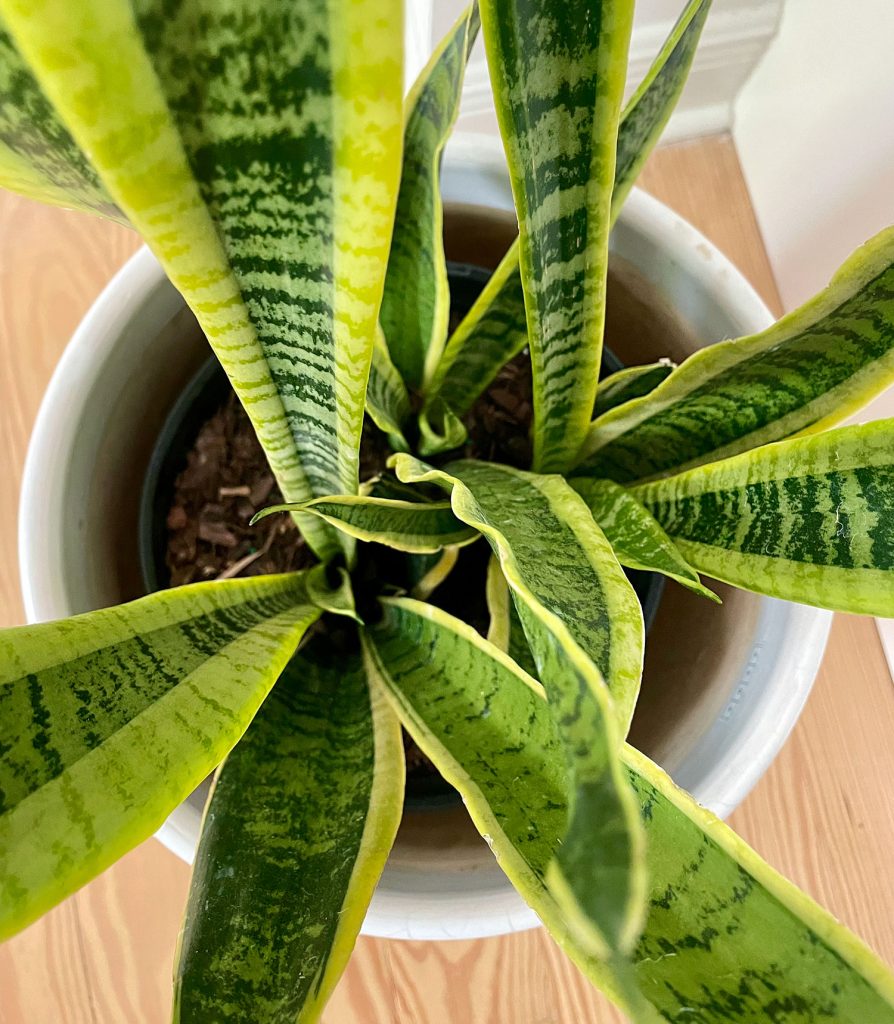
In addition to regular watering, consider taking the following steps to help your snake plant thrive:
- Dust & wipe leaves: Use a damp cloth or plant wipe to clean its leaves, just like you dust any other surface in your home. This helps your plant look clean and shiny, while also removing dust that may impede photosynthesis.
- Turn your pot: Consider slightly rotating your snake plant every time you water to encourage even growth, especially if it lives near a window. This helps to ensure that all sides get equal sunlight.
- Fertilizing: Give your snake plant a boost with a balanced fertilizer, ideally with a NPK of 10-10-10, such as this general plant food or this special snake plant fertilizer. Follow the bottle’s directions, but generally you apply once every 2-4 weeks during its growing season.
- Prune: Prune your snake plant as needed to remove dead or damaged leaves, control height & shape, and encourage new growth. Use sharp clean scissors to clip leaves at the soil line.
How to Propagate A Snake Plant
Snake plants can be easily propagated to create new plants for yourself or a friend.
Step 1: Take a leaf cutting
Use sharp clean clippers to cut a healthy leaf right at the soil line. Since snake plants don’t grow from stems or vines like other houseplants, you don’t have to worry about finding the right “node” for your cut. Consider cutting a V-shaped notch on the bottom to expose more surface area for roots to grow.
Step 2: Propagate the clipping in water
Fill a clear cup, vase, or vessel with at least 2″ of water. Stick your cut leaf inside and place it in a partially sunny spot, like a windowsill. You can even put multiple clippings in the vase to create an attractive arrangement. Refresh the water every 1-2 weeks.
Step 3: Once rooted, transfer to soil
Once your clipping has started to sprout roots at least 1″ long, it can be transferred to a pot with soil. This may take several weeks. Remember to use loose soil for optimal drainage. A cactus, palm, or succulent soil mix is best.
Once your clipping is potted, care for your new snake plant just as you would a mature plant.
Common Snake Plant Issues
Like any houseplant, snake plants are susceptible to common problems and pests that can be easily remedied if you know what to look for.
- Yellow or brown leaves: You are likely overwatering your Snake Plant. Let the soil fully dry out before adding more water and put more space between your regular waterings. If that does not resolve your issue, you may need to repot with fresh soil and remove rotted roots. Yellow leaves also may be a sign of overfertilizing.
- Burned or spotted leaves: Your plant is receiving too much direct sunlight. Find a new spot where it will get more indirect light.
- Drooping or wilting leaves: This could be a sign of too little light, too much water, or poor soil. Adjust the first two and if that does not work, replace the soil with fresh, better draining soil.
- Pests: Snake plants may attract common pests like aphids, gnats, mealybugs, spider mites, and more. Look for damaged spots, wilting leaves, or webs. Most pests can be removed by hand and then you can treat the plant with neem oil.
Other Snake Plant FAQs
Are Snake Plants toxic to pets?
Snake plants are mildly poisonous to cats, dogs, and humans when ingested. The leaves contain a toxic chemical called saponins that can cause gastrointestinal issues like nausea, vomiting, or diarrhea when consumed in high quantities. It’s best to keep your snake plant out of reach of pets or small children who are known to nibble your plants.
Why are snake plants so popular?
Who doesn’t love a low-maintenance, super forgiving, low-light tolerant plant? Snake plants are also a unique-looking houseplant with bright foliage and vibrant variegations. Additionally, they are great air purifiers and in Feng shui are thought to bring good luck and prosperity.

Can snake plants live outside?
Snake plants can survive outdoors in certain conditions. They are native to West Africa and prefer hot and dry climates. In the United States, they’re rated for zones 9-11 of the USDA Plant Hardiness Map. However they can’t survive frost and dislike temperatures under 50º, so they will likely need to be brought indoors during the winter months.
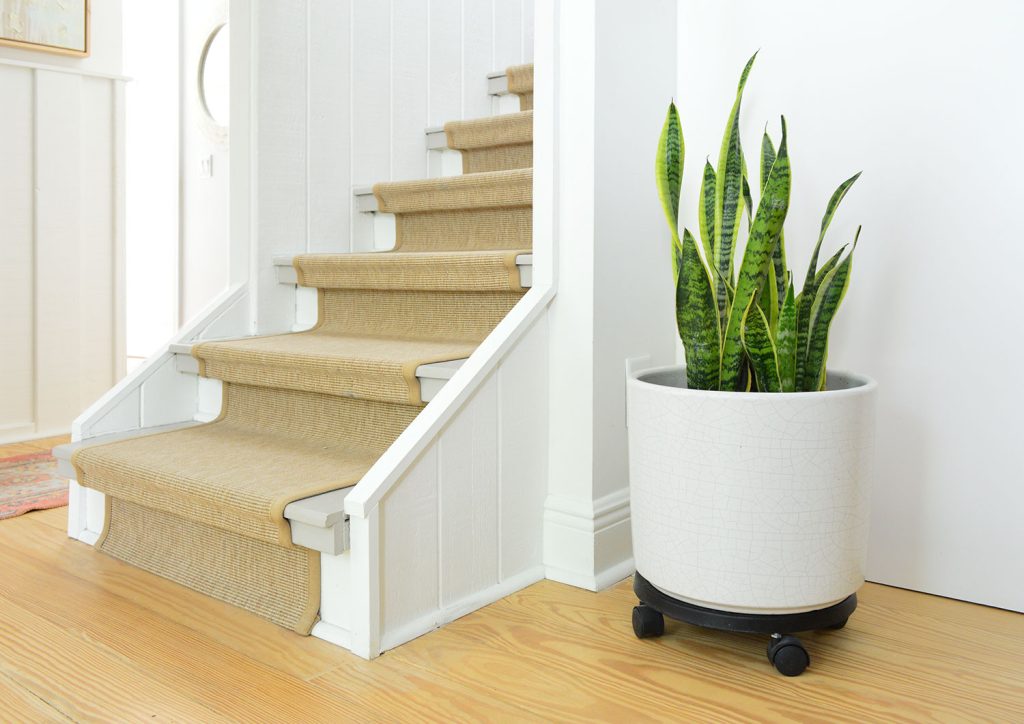
Do snake plants flower?
Snake plants produce wispy white or yellow flowers in their native environment. However, your houseplant is unlikely to flower. Snake plants typically only flower indoors when the plant is stressed and is looking to reproduce (pollinated flowers turn into berries that can grow new plants). You can experiment with neglecting your snake plants to try to force flowering – like not repotting or severely underwatering it – but be careful not to irreversibly damage your plant.
What other types of snake plants are there?
Within the Dracaena trifasciata species, there are other popular snake plant cultivars besides the Laurentii shown here. Among them are a smaller version called the Bird’s Nest Snake Plant (Dracaena trifasciata ‘Hahnii’) and Twister Sister (Dracaena trifasciata ‘Twisted Sister’) whose leaves twist. Other popular species include:
- Dracaena patens: a smaller, less upright snake plane
- Dracaena pearsonii: Known as “Rhino grass” because of its short, horn-like leaves
- Dracaena masoniana: Known as a “whale fine snake plant” that features wider leaves.
More Plant Guides
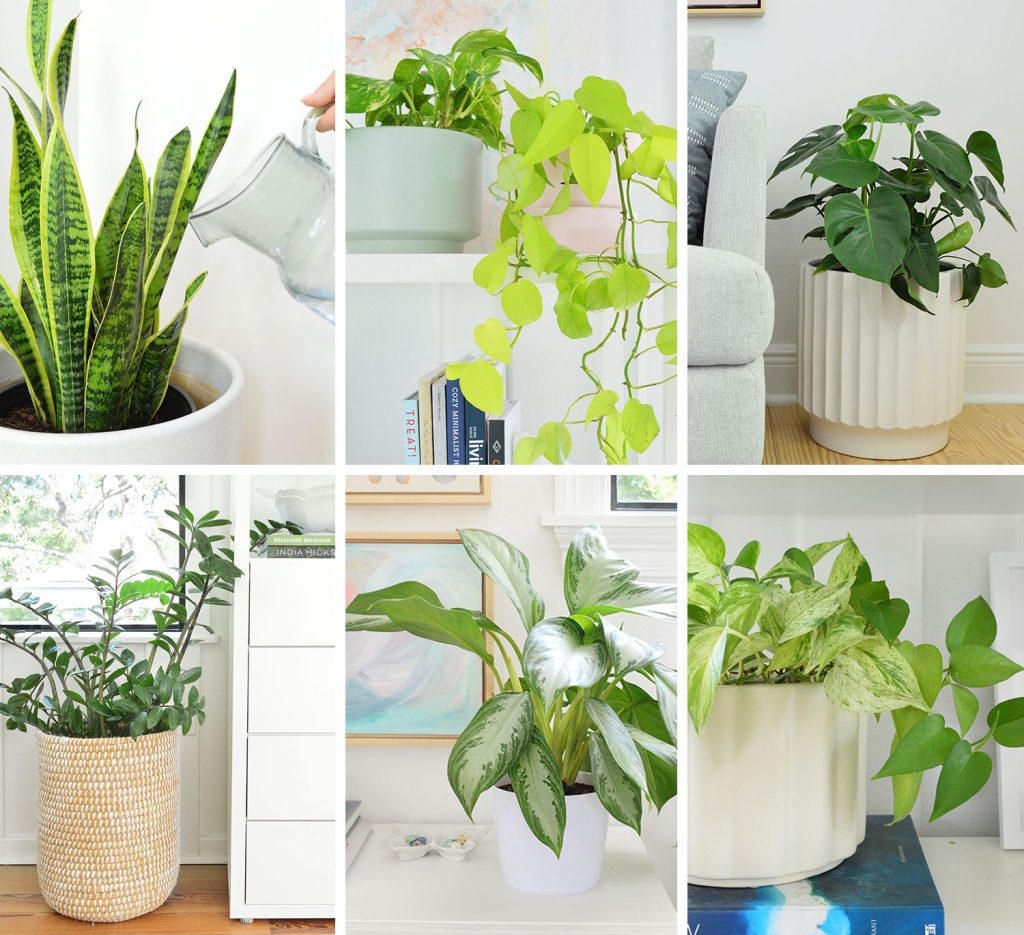
If you’re looking for more information on some of our favorite plants, check out some of these posts below:
- Best Low-Light Houseplants
- Best Air Purifying Indoor Plants
- Golden Pothos Care Guide
- Neon Pothos Care Guide
- Mable Queen Pothos Care Guide
- Fiddle Leaf Fig Care Guide
- Aglaonema Plant Care Guide
- Corn Plant Care Guide
- Tree Philodendron Care Guide
- Monstera Deliciosa Care Guide
- How to Build An Easy Plant Shelf
- Protecting Outdoor Plants In A Deep Freeze
- Getting Started With Houseplants, An Expert Interview
*This post contains affiliate links, so we may earn a small commission when you make a purchase through links on our site at no additional cost to you.
